Maryland Fishing Report – June 2

Richard Hoene was sitting at a dock in Ocean City on Memorial Day weekend and, being an ever hopeful and dedicated angler, cast a line into the water. His efforts were rewarded with this large striped bass. Photo courtesy of Richard Hoene
One of the most important lessons in any kind of fishing is the value of eternal hope — and that no matter the conditions, you do not stand a chance of catching a fish unless you have a line in the water.
The Maryland Department of Natural Resources has some free fishing days coming up, which allows folks to fish anywhere in Maryland without a fishing license on June 5, June 12, and July 4. This is a wonderful opportunity to introduce someone new to the world of fishing.
All areas in Maryland’s portion of the Chesapeake Bay and its tidal rivers are now open to striped bass fishing. The minimum size for striped bass is 19 inches with a limit of one fish per day.
Forecast Summary: June 2 – June 8:
Despite a chance of rain and windy conditions on Thursday and Friday, warmer weather forecasted this week should slowly warm Bay water temperatures. Bay surface water temperatures are in the upper 60s and low 70s, and will continue to rise this week. Preliminary May monitoring data is showing main bay bottom waters are slightly cooler than surface waters, and beginning to show some poor oxygen conditions, so it is likely striped bass will be higher in the water column to find adequate oxygen and their preferred water temperatures. Due to low bottom oxygen levels, avoid fishing below the following depths and these locations: Swan Point, 20 feet; Bay Bridge to Bloody Point, 30 feet; Choptank River to Point No Point, 45 feet. Conditions can vary daily so be sure to check the depth to oxygen level online prior to your next fishing trip.
Expect average flows for most Maryland rivers and streams. There will be above average tidal currents from Sunday through Tuesday as a result of the new moon June 10. Expect average clarity for Maryland portions of the Bay and rivers. There will be poor water clarity due to algal blooms on the Susquehanna Flats, Sassafras River above Georgetown, Bush River, and Potomac River near Colonial Beach.. To see the latest water clarity conditions, check Eyes on the Bay Satellite Maps.
For more detailed and up-to-date fishing conditions in your area of the Bay, continue to check out Click Before You Cast. Get regular updates on Maryland’s waters sent to your inbox with our Eyes on the Bay newsletter. Sign up online.
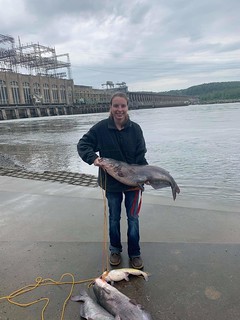
Josie Baugher holds up one of the blue catfish she caught recently at the dam pool. Photo courtesy of Josie Baugher
There are some good fishing opportunities for striped bass in the Susquehanna Flats area and at the Conowingo Dam pool. Anglers at the flats are finding the best fishing in the morning and evening hours along the channel edges and drop-offs. Most are casting 5-inch to 6-inch soft plastic jigs and paddletails with good success. As can be imagined a percentage of the fish being caught are falling a few inches short of the 19-inch minimum. Casting soft plastic jigs is also working well at the dam pool . Those that arrive at the flats or dam pool at the crack of dawn or sunset are also having good luck with topwater lures.
Live lining small white perch is working for those working the channel edges near the flats. Chumming will work in the channels below the mouth of the Susquehanna but often draw the undivided attention of blue and channel catfish. Circle hooks must be used when targeting striped bass.
Fishing for white perch is very good in the lower Susquehanna River and the tidal creeks and rivers of the upper Bay region. Casting small beetle spins, small spinnerbaits, and spinners are favorite ways to fish for them with light tackle near shoreline structure. Using grass shrimp or pieces of bloodworm on a bottom rig work well in deeper waters. Northern snakeheads will be found in the lower Susquehanna River and just about every tidal creek and river within the upper Bay region.
Blue and channel catfish are providing a lot of fishing action this week throughout the upper Bay. The blue catfish are very prolific in the lower Susquehanna River area and the Chester River. Blue and channel catfish will also be caught incidentally by those chumming in the upper Bay. The Conowingo Dam pool is an excellent place to fish for blue catfish from shore.
Those fishing for striped bass are finding them along channel edges and structure. Trolling medium-sized bucktails along channel edges, and umbrella rigs weighted to get down to the 40-foot channel edges, works well, and white tends to be the most productive color. Jigging is effective at locations such as the Love Point Rocks and the Key Bridge and Bay Bridge piers. Skirted jigs in various color schemes of pearl, white, and chartreuse are working well when cast tight to structure. Chumming is another way to fish for striped bass and Podickory Point, Love Point, and the Key and Bay Bridge are popular places to chum.
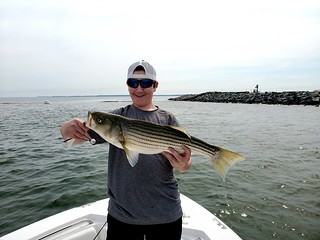
Joshua Pepin caught this nice striped bass while casting a soft plastic jig at Poplar Island. Photo courtesy of Joshua Pepin
Trolling, jigging, chumming, live lining, and shallow water casting — these are all methods being used this week to fish for striped bass in the middle Bay. Those trolling are working the shipping channel edges and the channels leading out of the major tidal rivers. The 40-foot shipping channel edges are a popular draw and umbrella rigs with heavy inline weights are being used to get down to the fish. Shallower depths in the water column are being covered by single or tandem rigged bucktails in white or chartreuse. The outside edge of Hacketts, Bloody Point, Thomas Point, the Buoy 83 edge, and the False Channel are traditional locations to troll this week.
Those light-tackle jigging are cruising the same channel edges as above and anywhere striped bass can be found suspended off the bottom. Skirted plastic jigs in the 6-inch or larger category are favorites. Working the channels in the lower end of the region’s tidal rivers is also producing some striped bass in 15 feet to 20 feet of water. All of the tidal rivers are open to striped bass fishing now, so many are exploring areas that were previously off limits.
Some industrious anglers are finding spot for live lining at channel edges, while others are using small white perch. The 35-foot to 40-foot shipping channel edges or anywhere fish can be spotted suspended on a depth finder are being explored. Others are setting up chum slicks and drifting cut menhaden baits. A fair percentage of fish are coming up slightly short of the 19-inch minimum. Remember, circle hooks are mandatory when targeting striped bass with any kind of bait.
The shallow-water fishery for striped bass has become a new game with the influx of speckled trout in the shallower waters of the middle Bay and in particular the Eastern Shore. Casting paddletails in white, pink, and other color combinations is the best way to target the speckled trout. Striped bass will be part of the mix or one can cast topwater lures for some surface excitement.
White perch are providing a lot of fun fishing this week in the tidal rivers and creeks of the middle bay. They can be found near shoreline structure, oyster bottom, and dock and bridge piers. Casting beetle spins, small spinnerbaits, and spinners are a fun way to fish for them along the shorelines of the rivers and bay in the morning and evening hours. Any other time, dropping a simple bottom rig baited with grass shrimp or pieces of bloodworm near dock piers or any kind of bottom structure is a great idea.
Northern snakeheads are spawning in most of the region’s tidal rivers and creeks this week and holding tight in shallow grass areas. To catch their attention it will take something like a noisy threatening chatterbait pulled right through where they are protecting their brood.
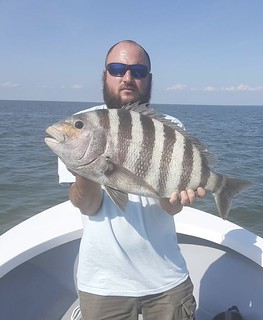
Other summer species are moving into the lower bay this week and Logan Crockett must have been surprised when he caught this large sheepshead recently. Photo courtesy of Logan Crockett
Speckled trout is the biggest fishing topic in the lower bay right now. The fish moved up into the area a week ago and have been dominating the interest of light-tackle anglers. The shallows of Tangier Soundup to Hoopers Island are the most popular places to fish for them, but they can also be found in the lower Potomac River and the western side of the bay. Casting white and pink paddletails, grubs, and various soft plastic jigs has been the most popular way to fish for them in grassy shallows. Casting Zara Spooks over grass and in stump fields offers plenty of speckled trout and striped bass action in the morning and evening hours. Many of the striped bass being caught are reported to be a bit shy of 19 inches, but are still a lot of fun on light tackle.
Those wishing to troll for their striped bass are doing so along the shipping channel edges on both sides of the bay and the lower Potomac. The edges at Cove Point, Point No Point, Buoy 72, and the lower Potomac between St. Georges Island and Piney Point are popular locations. Most anglers are pulling umbrella rigs deep with white or chartreuse bucktails or tandem rigged bucktails higher in the water column. Those looking for some light tackle jigging action are checking channel edges for suspended fish, Cedar Point, or the reef at Point No Point with their depth finders. Soft plastic jigs in the 6-inch size range are the most popular option.
Live lining is a viable option in the lower bay, and spot are available in the mouth of the Patuxent and lower Potomac rivers. The channel edges in front of Cove Point, Cedar Point, and the steep channel edge in the lower Potomac from St. Georges Island to Piney Point are popular places to live-line spot. A few boats have also been anchoring up and chumming in these locations and report spotty results with striped bass but plenty of blue catfish on cut menhaden baits.
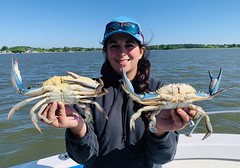
Angelina Watts holds up two whoppers caught while trot lining in the Kent Island area with her dad this week. Photo by Rich Watts
A mix of spot, white perch, and small croakers are being caught on hard bottom in the lower Patuxent River, Cornfield Harbor on the lower Potomac, and Tangier Sound at the Sands. Flounder are being caught along the channel edges in Tangier Sound along with speckled trout on soft plastic jigs. A few large red drum are being caught and released by those using soft crab baits near the Mud Leads, black drum can also be in the mix as well.
There have been reports of some blue crabs being caught in the mouth of the Magothy River by those using trotlines. In the middle bay, crabs are being found shallow in many of the tidal creeks and rivers, where water temperatures are in 60s. Recreational crabbers report being able to catch a couple dozen in the middle bay region and up to a half bushel in the lower Eastern Shore region. Most of the larger crabs are those that held over the winter. Recreational crabbers report sooks are chewing up baits. Some are forking over the money for razor clams, which have hit an all-time high of $80 to $100 a bushel.
Deep Creek Lake is settling into a summer type of fishing scene. Boat traffic is increased, floating docks are deployed all around the lake, and vacationing families are enjoying time out on the lake fishing. Bluegills are providing plenty of fun fishing for anglers of all ages. Smallmouth bass, large yellow perch and walleye can be found along deep grass edges by drifting live minnows or working deep running shad raps along those edges. Water temperatures are in the low to mid 60’s in the lake.
Trout management waters in the central and western regions of the state are showing good water flows due to recent rains. There are still trout to be found in many of the put-and-take areas and the delayed harvest areas are now open to harvest.
The upper Potomac River is calming down from the weekend’s heavy rains and is suitable for fishing for smallmouth bass. Casting small crankbaits, tubes, and soft plastic grubs along current breaks, underwater ledges, and large boulders is a good bet. In the early morning hours, casting topwater lures along the shallower areas can provide some exciting surface action. Smallmouth bass are keying in on cicadas in areas of eruption.
Largemouth bass are slowly shifting into a summer mode of behavior, as water temperatures rise and the periods of daylight become longer and warmer. The early morning and evening hours will become some of the best times to target largemouth bass along the shallower areas where they are feeding. Casting topwater lures over or near grass beds is a fun and exciting way to fish — chatterbaits, lipless crankbaits, and a variety of soft plastics work well. Largemouth bass will also be taking hapless cicadas that fall on the surface of the water.
As the day wears on, largemouth bass will seek cool shade under grass mats in deeper water, shade under docks, fallen treetops, brush, or undercut banks. Casting wacky rigged soft plastic worms or similar plastics is a great way to target them.
Northern snakeheads are holding in shallow grassy areas this week as spawning is underway. Targeting them in the shallows with chatterbaits is perhaps one of the best tactics at this time.
You can help fight the invasive at a snakehead fishing event called Snakes on the Dundee at Gunpowder Falls State Park June 26. The event location is 7200 Graces Quarters Road, Middle River. Registration is free and this is a great event to learn about northern snakeheads. Register on the DNR website.
Crappie and bluegill sunfish are in their post-spawn behavioral stage and will provide plenty of good fishing. The crappie can be found holding near marina docks, sunken wood, fallen treetops, and bridge piers. A small live minnow under a slip bobber is an excellent way to target them. Bluegills always provide plenty of fun summer fishing, whether one is fishing with a simple bait and bobber rig or is casting small poppers or flies such as hoppers with a lightweight fly rod.
Blue catfish continue to provide plenty of good fishing and excellent table fare this week in many areas of Maryland. The tidal Potomac, Patuxent, Susquehanna, and Nanticoke rivers and their tributaries all provide excellent fishing opportunities for blue catfish. Channel catfish can also be found in these areas as well as every tidal river that feeds into the Chesapeake.
Surf anglers are enjoying excellent fishing for kingfish, with a mix of northern blowfish and sea trout as well. Pieces of bloodworms, cut bait, and Fishbites are popular baits. Flounder and blowfish are being caught on squid. Those soaking large cut baits of menhaden are being rewarded with a large striped bass now and then.
At the inlet and Route 50 Bridge area, flounder are being caught and many are enjoying some fun catch-and-release action on striped bass that fall short of the 28-inch minimum. Bucktails, paddletails, and soft plastic jigs are the favored lures to use.
The back bay areas are beginning to clear up after last weekend’s intense windstorm. As most anglers know, clear water conditions are essential for good flounder fishing. The channel areas will be good places to target them this week with large soft plastic jigs or traditional baits of squid and live minnows.
The captains taking anglers out to the offshore wreck and reef sites for black sea bass report excellent catches, with limit catches being very common. Those heading out to the canyon areas report good deep-drop fishing for blueline and golden tilefish. Bluefin tuna are being caught offshore this week and other pelagic species will fill in soon, anyone fishing for them must be familiar with the Maryland Catch Card Program in Ocean City. You can learn more at the NOAA website , and the online HMS Recreational Compliance Guide.
“A fish story needs no apology; and no affidavit nor string of affidavits can add anything to its credibility.” — David Starr Jordan
Maryland Fishing Report is written and compiled by Keith Lockwood, Maryland Department of Natural Resources fisheries biologist.
Click Before You Cast is written by Tidewater Ecosystem Assessment Director Tom Parham.
This report is now available on your Amazon Echo device — just ask Alexa to “open Maryland Fishing Report.”

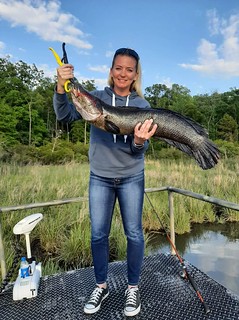

 1-888-373-7888
1-888-373-7888 233733
233733